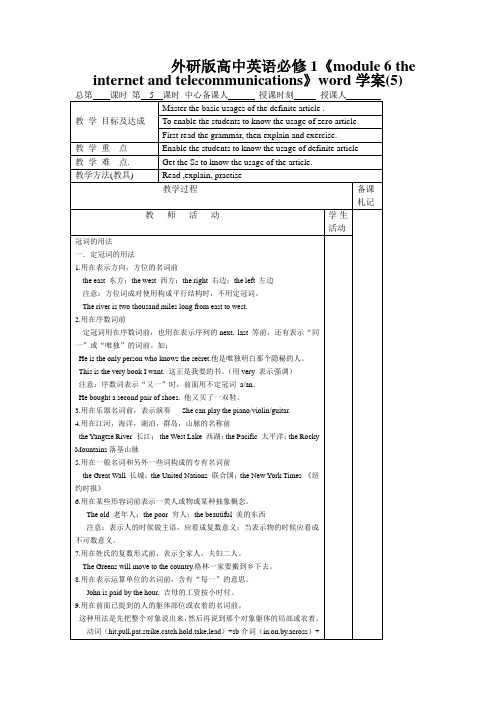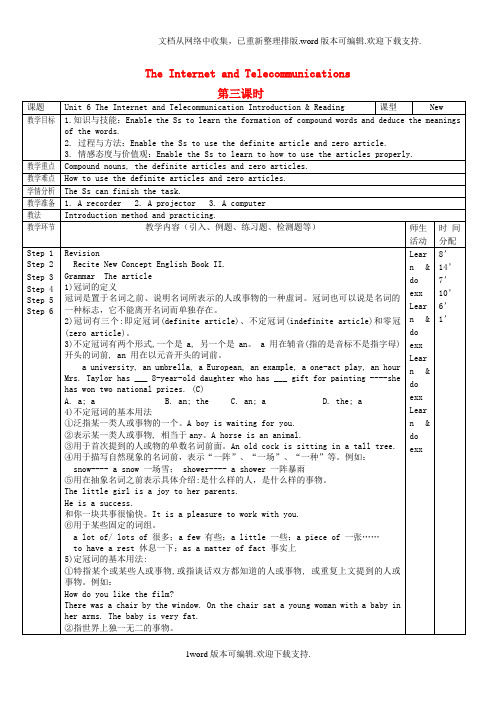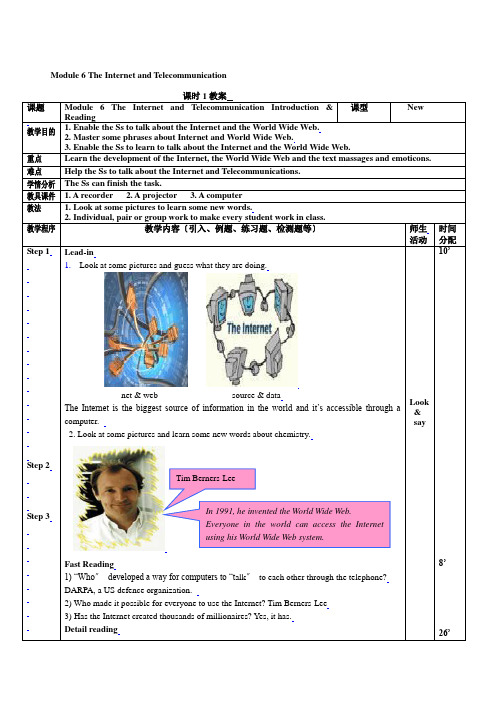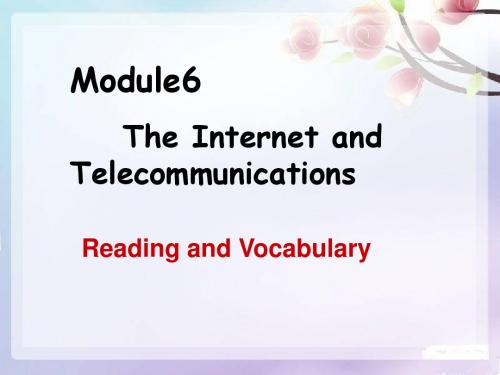必修一module6 internet introduction
- 格式:pptx
- 大小:3.21 MB
- 文档页数:65




Module 6 The Internet and Telecommunication课题教学目的重点 难点 学情分析 教具课件 教法教学程序Step 1课时 1 教案Module 6 The Internet and Telecommunication Introduction & 课型NewReading1. Enable the Ss to talk about the Internet and the World Wide Web.2. Master some phrases about Internet and World Wide Web.3. Enable the Ss to learn to talk about the Internet and the World Wide Web.Learn the development of the Internet, the World Wide Web and the text massages and emoticons.Help the Ss to talk about the Internet and Telecommunications.The Ss can finish the task.1. A recorder 2. A projector 3. A computer1. Look at some pictures to learn some new words. 2. Individual, pair or group work to make every student work in class.教学内容〔引入、例题、练习题、检测题等〕师生 活动Lead-in1. Look at some pictures and guess what they are doing.时间 分配 10’net & websource & dataThe Internet is the biggest source of information in the world and it’s accessible through acomputer.2. Look at some pictures and learn some new words about chemistry.Look & sayStep 2Tim Berners-LeeStep 3In 1991, he invented the World Wide Web. Everyone in the world can access the Internet using his World Wide Web system.Fast Reading8’1) “Who〞 developed a way for computers to “talk〞 to each other through the telephone?DARPA, a US defence organization.2) Who made it possible for everyone to use the Internet? Tim Berners-Lee3) Has the Internet created thousands of millionaires? Yes, it has.Detail reading26’Step 41. Para 1 Decide if these sentences are true.1) There are millions of pages of information on the Internet. ( T )2) The US army were the first people who used an Internet system. ( T )3) Universities started using the Internet at the same time as the army. ( F ) 4) The percentage of websites in English is getting smaller. ( T )5) Tim Berners-Lee made it possible for scientists to use the Internet. ( T ) 6) He has made a lot of money from his invention. ( F ) 2. Language points 1) The Internet is the biggest source of information in the world, and it’s accessible through a computer. (1) accessible 可接近的,可进入的,常用于 accessible to sb/ sthRead & lear nOur headmaster is accessible to the students. get/ gain/ have (no) access to sth 没有得到/获得/拥有某物的时机和权利Only high officials had access to the president. 只有高级官员才有时机接近总统。


Module 6 The Internet and Telecommunications Ⅰ. 模块教学目标Ⅱ. 目标语言Ⅲ. 教材分析与教材重组1. 教材分析本模块以Internet and Telecommunications 为话题,不仅要求学生了解有关电脑、网络、电信的词汇,而且要了解因特网的历史和电信业的迅猛发展及因特网在现代交际中的作用。
从情感上来讲,要求学生能正确地、客观地、辩证地看待因特网和现代通讯设备,积极利用因特网获取信息,使因特网能够更好地服务于自己的生活。
从语言知识上来讲,教师应帮助学生复习应用所学的构词法知识,熟练地组合新词汇,扩大词汇量。
从阅读角度来讲,要学会从文中获取信息,加工信息和准确筛选信息。
从写作角度来讲,利用本模块所学的词汇和短语,结合实际陈述自己对因特网的看法和意见,并学会如何陈述相反的观点。
在WORKBOOK 中要求对学校的设施做简单的介绍,并且对需要改进的地方提出自己的看法。
1.1 INTRODUCTION通过一幅电脑图片,要求学生说出并掌握电脑各部件的名称,学会用简单的英语来解释这些英语单词。
同时给出了许多新词汇,学生根据不同的语境来选择词义,为以后的阅读奠定基础。
1.2 READING AND VOCABULARY课文分六段三部分。
分别介绍了因特网、因特网的兴起、万维网和万维网的发明。
通过学习本文,学生可以了解到关于因特网和万维网的知识。
课后设置了正误判断题和选择题,旨在让学生从文中获取信息并能准确理解文章内容,同时帮助学生进一步巩固和掌握新词汇。
1.3 GRAMMAR1部分介绍了构词法知识——合成词的构成。
要求学生了解合成词的三种构成方式,并通过相关的练习学会运用名词的构成法猜测新词的意思。
1.4 LISTENING AND VOCABULARY通过一段采访录音,培养学生准确获取听力材料中有效信息的能力。
要求学生正确理解对话内容并推断不同说话者的观点和态度。
导学案Module 6 The Internet and TelecommunicationsReading and VocabularyTask1 A small quizTask2 Fast reading1.Which is the best title___________?A. The definition and the development of the Internet.B.How to use the World Wide Web?C.Berners-lee developed the Internet.D. The Internet creates many millionaires.2.Match the main idea with each paragraph.Para.1 A. the definition of the World Wide Web.Para.2 B. the inventor of the World Wide Web.Para.3 C. the current condition of Berners-Lee.Para.4 D. the development of the Internet.Para.5 E. the start of the Internet.Para.6 F. the definition of the Internet.Task 3 Scanning (True or False)1.There are millions of pages of information on the internet. (para1)2.The US army were the first people who used an internet system. (para2)3.Universties started using the internet at the same time as the army.(para3)4.The percentage of websites in English is getting smaller.(para4)5.Tim Berners-Lee made it possible for scientists to use the Internet.(para5)6. He has made a lot of money from his invention.(para6)Task 4 Careful readingFill in the blanksdevelopment of the Internet19691984 1991 inventornameuserTask 5 difficult sentences:Decide which sentence means the same as the extracts from the reading passage.1.For fifteen years, only the US army could use this system of communication.(para2) (a)The US army only used this system for 15 years.(b)After 15 years, other people were able to use it as well.2. The World Wide Web…allows computer users to access information…(para2)(a)Computer users can access information because of the World Wide Web.(b)You need permission from the World Wide Web before you can access information.3. About 80 percent of web traffic is in English, but this percentage is now going down.(para3)(a)Web traffic in English is becoming less interesting.(b)The percentage of English websites is getting smaller.4. He came up with the idea of the World Wide Web.(para4)(a)It was his idea.(b)He found the idea in a bookTask 6 Retell the passage in the first personRetell the passage according to each paragraph.Task 7 Read a short summary written in the third person.The Internet is the biggest source of information in the world, which consists of millions of pages of data. It dates back to 1969 when a US organization developed a way for all their computers to “talk” to each ot her through the telephone. Thus DARPANET, a network of computers came into being. But it was only used by the US army. Then in 1984, the NSF started the NSFNET network, which became known as the Inter-Network. Later an English scientist came up with the idea of the World Wide Web while he was working in Switzerland in 1989. He designed the first “web browser”, which allowed computer users to access documents from other computers. From that moment on, the Internet grew. Within five years, the number of Internet users rose from 600,000 to 40 million.Task 8 DebateTalk about the advantages and disadvantages of the Internet.Task 9 Homework1.Review the passage and find out the difficult language points in the passage.2. Finish Exercise 2 in Grammar on page 54.。